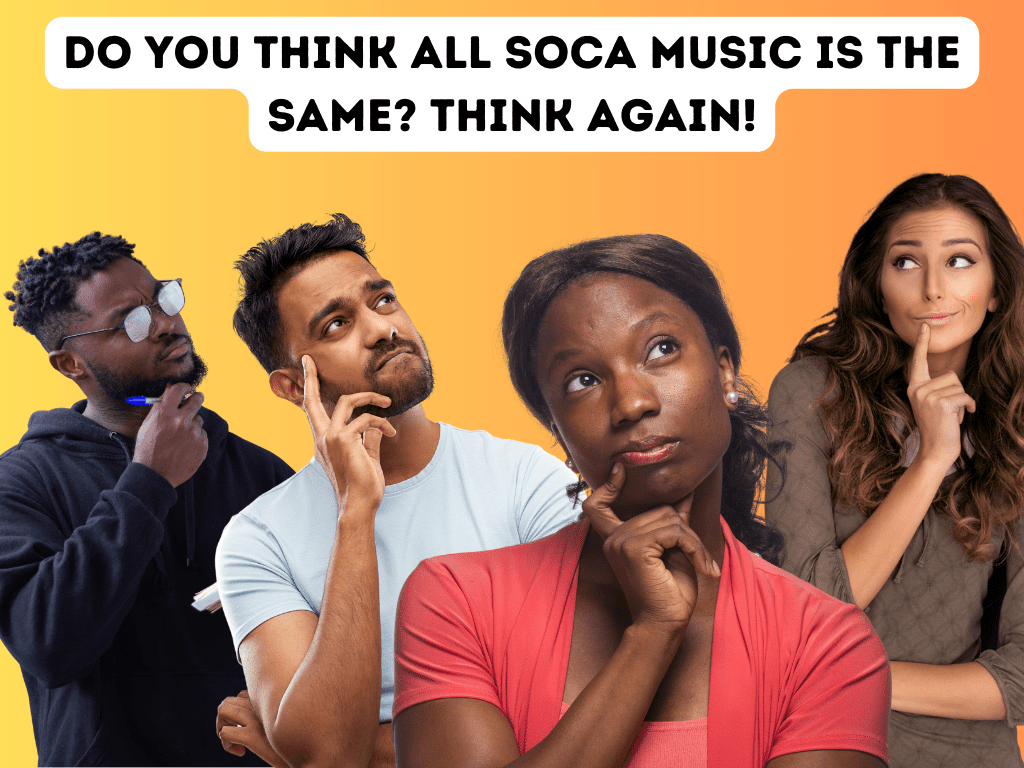Listen to the blog below
Do You Think All Soca Music Is the Same? Think Again!
Soca music, born in Trinidad and Tobago in the 1970s, has grown into a rich and diverse genre that goes far beyond its high-energy carnival roots. If you’ve ever thought, “All soca sounds the same,” you’re not alone—but that couldn’t be further from the truth. Soca has evolved into multiple subgenres, each with its unique vibe, rhythm, and cultural influences. Let’s break down the differences, where you can find these styles, and which are most popular today.
Power Soca: The Heartbeat of Carnival
What It Is:
Power soca is the high-octane, fast-paced heartbeat of Caribbean carnivals. Known for its rapid tempo (ranging from 160-180 BPM), this style is designed to make you jump, wave, and “get on bad.” Power soca is all about crowd participation, commanding revelers to dance and shout in unison.
Where It’s Found:
Power soca dominates carnival events, particularly in Trinidad and Tobago, Grenada, and Barbados during Crop Over. Hits like Machel Montano’s “Like Ah Boss” epitomize this genre.
Popularity:
Power soca thrives during the carnival season but takes a backseat to groovy soca outside the festivities.
Groovy Soca: For the Whiners
What It Is:
Groovy soca offers a slower, more melodic alternative to power soca, perfect for dancing intimately or “whining.” Its tempo, typically 115-130 BPM, creates a smooth, infectious rhythm.
Where It’s Found:
Groovy soca dominates party playlists and fetes year-round. It’s particularly popular in Trinidad and Barbados, with artists like Kes (“Savannah Grass”) and Voice (“Cheers to Life”) leading the charge.
Popularity:
Groovy soca is arguably more versatile than power soca, making it a global favorite beyond carnival.
Chutney Soca: East Meets West
What It Is:
Chutney soca blends traditional Indian rhythms with soca beats, reflecting the Indo-Caribbean influence in countries like Trinidad and Guyana. Lyrics often explore love, heartbreak, or cultural themes.
Where It’s Found:
Primarily in Trinidad and Guyana, chutney soca is celebrated at events like the Chutney Soca Monarch competition. Popular tracks include Ravi B’s “Dularie Nanny.”
Popularity:
While niche, chutney soca has a dedicated fanbase within the Indo-Caribbean community.
Ragga Soca: The Dancehall Twist
What It Is:
A fusion of soca and reggae/dancehall, ragga soca incorporates heavy basslines and a Jamaican patois influence. It’s slower and grittier than traditional soca.
Where It’s Found:
Ragga soca is especially popular in Barbados and St. Vincent, with hits like Rupee’s “Jump” and Kevin Lyttle’s “Turn Me On.”
Popularity:
This subgenre bridges Caribbean communities, making it a staple at multicultural events.
Bouyon Soca: The Dominican Innovation
What It Is:
Hailing from Dominica, bouyon soca fuses soca with Bouyon music—a genre known for its heavy drums, keyboard riffs, and catchy hooks. The result is an electrifying, rhythm-heavy sound.
Where It’s Found:
Dominica and neighboring islands like St. Lucia are the strongholds of bouyon soca. Asa Bantan and Triple Kay Global are key artists.
Popularity:
Bouyon soca is growing in popularity, thanks to its appeal at regional carnivals.
Afro Soca: The African Connection
What It Is:
Afro soca blends African rhythms and instruments with soca beats, celebrating the shared heritage of African and Caribbean cultures.
Where It’s Found:
This subgenre thrives at African-Caribbean festivals worldwide, with artists like Nailah Blackman and Afro B (“Juice & Power”) leading the charge.
Popularity:
Its global appeal makes Afro soca a rising force in the music industry.
Dennery Segment (Soca): The St. Lucian Flavor
What It Is:
This St. Lucian variant of soca features Creole lyrics, pounding percussion, and provocative themes. It’s raw and unapologetically bold.
Where It’s Found:
Dennery Segment is St. Lucia’s pride, dominating events like their annual carnival.
Popularity:
It’s growing internationally, especially among younger listeners.
Parang Soca: Christmas Vibes
What It Is:
A festive blend of soca and traditional Parang music, parang soca is synonymous with Caribbean Christmas celebrations.
Where It’s Found:
Trinidad and Tobago lead the charge, with hits like Scrunter’s “De Parang Now Start.”
Popularity:
Seasonal but beloved during the holidays.
Jab Jab Soca: The Dark Carnival
What It Is:
Rooted in Grenada, jab jab soca has a darker, rawer tone, often tied to Grenadian carnival traditions involving mud, oil, and devilish costumes.
Where It’s Found:
Grenada’s Spicemas is the ultimate destination for jab jab soca fans.
Popularity:
Its niche appeal doesn’t stop it from making waves at carnivals worldwide.
Which Subgenre Reigns Supreme?
The most popular soca styles depend on the audience and event. Globally, groovy soca has the broadest appeal due to its versatility and dance-friendly beats. However, during carnival season, power soca takes the crown for its infectious energy. Chutney soca, Dennery Segment, and jab jab soca cater to specific cultural and regional audiences, while Afro soca is emerging as a global fusion genre with mass appeal.
Conclusion
Far from being “all the same,” soca music is a rich tapestry of styles reflecting the diversity and creativity of the Caribbean. Whether you’re a fan of the fast-paced madness of power soca, the smooth grooves of groovy soca, or the cultural fusion of chutney and Afro soca, there’s something in this genre for everyone. Next time you hear a soca track, take a moment to appreciate its unique flavor—you might discover a new favorite!
SHARE THIS WITH THAT FRIEND THAT THINKS IT'S ALL THE SAME















